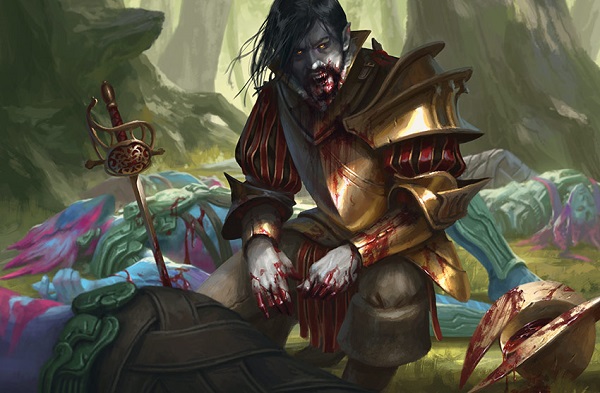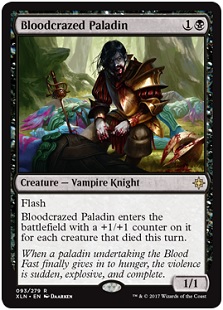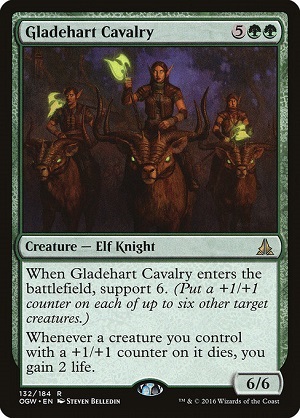Today, I am going to talk about one card art illustration from Mike “Daarken” Lim. The card artwork was released on Monday for this card, Bloodcrazed Paladin, and my entire article today is spending time to soak up all the visual information from the artwork.

Bloodcrazed Paladin by Daarken
Digital
This is a . . . Conquistador, right?
 If you found yourself lucky to have strong history teachers in high school, they were able to unwind some of the rhymes about Columbus from celebration into genocidal reality. The armor here, especially the breastplate and helmet, or morion here, have been ingrained into popular culture as “conquistador” and the baggage that comes with those connotations is carried into Magic. That’s what they wore if they had the means, when they got off the boat. Though after you get a hold of real reference material, like Bernardo de Vargas Machuca’s Indian Militia and Description of the Indies, you find out that many conquistadors realized that they had to adapt to the climate and fighting style of the population they were fighting. Now, the conquistadors from Spain varied as widely from Naya to Ixalan, though adapting was necessary. It’s often just easier to do a visual shorthand of 16th/17th century armor, a rapier sword, a morion and people understand that trope to be conquistadors from Spain to the “new world.” Showing them in cotton armor doesn’t fit the narrative and visual aesthetic though, does it?
If you found yourself lucky to have strong history teachers in high school, they were able to unwind some of the rhymes about Columbus from celebration into genocidal reality. The armor here, especially the breastplate and helmet, or morion here, have been ingrained into popular culture as “conquistador” and the baggage that comes with those connotations is carried into Magic. That’s what they wore if they had the means, when they got off the boat. Though after you get a hold of real reference material, like Bernardo de Vargas Machuca’s Indian Militia and Description of the Indies, you find out that many conquistadors realized that they had to adapt to the climate and fighting style of the population they were fighting. Now, the conquistadors from Spain varied as widely from Naya to Ixalan, though adapting was necessary. It’s often just easier to do a visual shorthand of 16th/17th century armor, a rapier sword, a morion and people understand that trope to be conquistadors from Spain to the “new world.” Showing them in cotton armor doesn’t fit the narrative and visual aesthetic though, does it?
What isn’t mentioned from the armor is the savagery and brutal behavior that conquistadors waged on the local Caribbean islands and Latin America. If you only have a rough understanding, which is totally normal, check out the Khan Academy recaps on the history of them. They’re surprisingly short and you may learn a thing or two. That overwhelming force, those conquerors, we are to take from the art description and style guide. The vampires are not considered the norm, they are invaders. They also aren’t that scary, compared to what colonist, conquistadors were, which Dave touches on as well.
I’m not sure how Wizards will ignore the overt visual references of colonization, as they avoided it wholeheartedly in Kaladesh. It’s worthwhile to touch on it, as having anything Latin American in nature cannot ignore the genocide these invaders inflicted. Comparing them to vampires is amusing to me, though I’m also an American who studied art history from afar.
Color Balance
Notice the color difference between the dark shine of the vampire vs. the colorful armor and body of the merfolk. A white person, dressed as a conquistador, covered in blood, has annihilated a small group of merfolk and looks unharmed. No allusion even needs to be made thereof a white person killing people of color. The “good” guy is not the one who survived.
Also to note, from a style guide perspective, is the allusion of colonization. One is to be shown as armor with proper clasps and fine silk compared to stone, leader and jade. We see a technology vs. nature theme, common to games to show differentiation between tribes and factions and staring us in the face, the merfolk haven’t stolen vampire armor and the vampires seem to be incredibly effective even with the heavy armor on. There is no need for guerilla warfare when you win with tactics learned back home in Spain, or wherever the vampires are from.
Elf Ears?
Speaking of the vampires being foreign, the pointed ears are consistent in the vampires and we must wrestle with the obvious question, can elves be vampires? (The eyes are not, check out Bishop of Rebirth.) We have no footing that the pointed ears on Bloodcrazed Paladin and others make them elves, but we can clearly see the ears.
Elves being fanatical to their religion is nothing new, plenty of other IPs have shown elves as unbending, writing love stories with elf/human connections. We don’t see many elf knights in Magic, only eight and they all have mounts. What would make an elf be knighted, thus becoming a lord? And why would a vampire retain characteristics of elves? Gluttony is what pushed another IP into gaining dark or evil elves, yet elves are restraint in Magic, each doing their small role in getting an “elfball” deck out, with a Craterhoof Behemoth for a win.
Vampires are Catholics?
 Tying the trope to Catholicism and Spanish conquest on a less technologically advanced Magic plane is surely new. This is far from what a Dungeons and Dragons paladin, or really any paladin, is known to be or is shown. They’re lawful good, the highest order of godliness and practice restraint. One of my AD&D characters is a paladin, and maintaining your lawful good alignment is often one of the hardest challenges of creating a party. Thieves in the party make you do mental gymnastics to see how someone could justify that. And here we see a vampire paladin? An embodiment of good just fed on a group of merfolk? That is a dissonance that begs for intrigue. This appears to an enfranchised player, an older Magic player to ask for more explanation and one who wants to smash tropes to find something utterly new.
Tying the trope to Catholicism and Spanish conquest on a less technologically advanced Magic plane is surely new. This is far from what a Dungeons and Dragons paladin, or really any paladin, is known to be or is shown. They’re lawful good, the highest order of godliness and practice restraint. One of my AD&D characters is a paladin, and maintaining your lawful good alignment is often one of the hardest challenges of creating a party. Thieves in the party make you do mental gymnastics to see how someone could justify that. And here we see a vampire paladin? An embodiment of good just fed on a group of merfolk? That is a dissonance that begs for intrigue. This appears to an enfranchised player, an older Magic player to ask for more explanation and one who wants to smash tropes to find something utterly new.
While Ant tells me there is also flavor text, I am trying to focus solely on the art. Needing to read the label in a museum just tells you the answer and forces you to stop looking at the art and move on. Note the next time you visit which paintings don’t have labels. Those often are the diamonds in the rough. As for another Catholic point, I reached out to Jay Annelli and he said the concerning point:
Bringing realism to fantasy. I swear I repeat those words in every art review I do. Here, they make the parallel to Conquistadors, who were Spanish and nearly universally Catholic after the Inquisition, then doubles down with a vampire in a religious service, albeit from a Magic lens.
To note, though, it’s too easy to show Catholics as less advanced or unwavering in their faith. From Byzantium and Protestantism, to the good and bad actors of faith in history, Catholics have impressions burned into our cultural memory of what they were and continue to be, whether warranted or not in their contemporary faith. The Crusades weren’t that great of an idea and civilians were slaughtered. The Inquisition was also not a good look. Showing a ![]()
![]() vampire, but also selfish, examines the selfish bishop that Ken Follett wrote at length in Pillars of the Earth and deals to examine how faith can be malleable, can even do evil acts. Saying maybe the vampires aren’t the actual conquistadors is a stretch, but that nuance of asking is great for game design. Maybe their god and the sun god are one and the same. Or perhaps what we see is what we get. With such a glut dropping in a day, we know they’re after gold and something more, but we are unsure what. Just as we can decipher who is the beatdown here, I am unwilling to commit to who is the real antagonist either.
vampire, but also selfish, examines the selfish bishop that Ken Follett wrote at length in Pillars of the Earth and deals to examine how faith can be malleable, can even do evil acts. Saying maybe the vampires aren’t the actual conquistadors is a stretch, but that nuance of asking is great for game design. Maybe their god and the sun god are one and the same. Or perhaps what we see is what we get. With such a glut dropping in a day, we know they’re after gold and something more, but we are unsure what. Just as we can decipher who is the beatdown here, I am unwilling to commit to who is the real antagonist either.
There is some type of code among the Legion of Dusk, where vampires aren’t mindlessly decimating a population each year, unlike the vampires of Innistrad, making me assume Sorin isn’t involved. Though, anytime Ugin is speculated, like he is here, notice his feathers and Quetzlcoatl does allow a rival faction of vampires to exist to oppose them. Enough flavor texts align to vampires being the other, which also flies in the face of elves, who often are remote and uninterested in normal discourse. They also don’t have beards in Magic, but you probably already knew that.

Cultural References
Magic had a woman captain in Sisay, though it was Gerrard’s tale, never quite hers. With women taking the center stage as pirates, look for male vampires to be the foil in terms of gender balance in the set. Tying that to Catholicism, again, reinforces why they are there.
Likewise, don’t expect a ton of fourth wall breaking for kid-friendly The Road to El Dorado moments. This image is stark, will appear at a moment’s notice, and can become very powerful due to someone else, a fitting parasite for the vampire tribe.
Art Itself
Our vampire is out in the daylight, meaning they aren’t affected by the sun. I did notice that some flavor text say they preferred the night, keeping with that alignment of the vampire trope. The face half obscured by light is a good touch, allowing us to focus on the character, a creature card, in the center with highlighted light telling us what to look at. By doing so, it opens up the rest of the 2x3” card art box up for the brightly lit merfolk on the ground. You can’t have bright with bright, it’s just too busy.
I do notice that this flashed in vampire is outside, not connected to a raiding party, and the act was seemingly random. This gives us some of the guerilla tactic information that conquistadors used, but it omits the greater part of the story. Are they not trying to convert any local humanoids? Because conversion to a faith is a radically faster way to rule a colony vs. military conquest. Converting them to a vampire seems ever faster and this vampire doesn’t appear to care about the aftermath. A good Catholic knows their restraint, except when humans are humans and they don’t.
I look forward seeing more. I’m patiently waiting to hear how the conquistador concept was used. It’s delicate. History has become better at messaging to say how brutal they really were. Magic designers know that history and I am eager to see how they handle using such a shell to enlighten, casting focus onto history using a mere card game. It’s a risk, but one worth examining and a phenomenal way to teach history. Let’s return to history and how the creation of games celebrates and subverts established historical thought.
—Mike




























